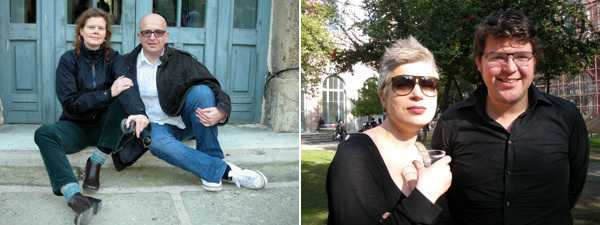ISTANBUL
11.15.10

WITH SO MUCH HAPPENING elsewhere in Istanbul—an opening at Rampa for the painter Ahmet Oran, a very VIP preview of Kutlug Ataman’s retrospective at Istanbul Modern, a new project by the critical darlings xurban_collective at Sanat Limani, Banu Cennetoglu’s first solo show at Rodeo, and a timely debate at Depo on the often violent relationship between art and gentrification—it was slightly frustrating to spend three full days stuck inside the Istanbul Technical University’s Architecture Faculty for a “research congress” organized two weeks ago by Former West. I’m sure there were worse places to be. Built as a medical school and military barracks for the Ottoman Army, the campus is a neoclassical jewel, with four pink façades lining a leafy courtyard with a reflecting pool and a lion fountain in the middle. But still.
Like a discursive sequel to Manifesta, Former West is a peripatetic platform investigating various histories of the post-1989 period. At the heart of the project, initiated by the BAK center for contemporary art in Utrecht, is the proposition, or maybe the hope, that the fall of the Berlin Wall didn’t necessarily signal the end of communism but rather the beginning of the end of capitalism, and with it, the hegemony of the West. Through seminars and symposia, Former West is trying to nudge that process along, or in congress-speak, to produce the West as former, and to posit that as a horizon for our time. The gist of the Istanbul gathering, titled “On Horizons: Art and Political Imagination,” was to say that the collapse of the Cold War system didn’t make utopian projects bunk; they just needed to be rebranded as horizons for anyone to take them seriously again.
In her opening remarks, BAK’s artistic director Maria Hlavajova purred a warm welcome to the digital masses following the live stream online. But for all the delirious talk of social media, by the time the congress ended, only one question had been posted on Facebook, followed by a note from the organizers saying, in effect, sorry we missed this, but someone will get back to you soon.
Hlavajova also struck a strange note when she quoted a headline from The Economist—“Turkey, turning its back on the West?”—and then said, “Calm down, the answer from the editors is no.” Was anyone in the audience really unhinged by the prospect? At this point, an artist I know was so turned off by the organizers’ tone that he got up, walked out, and never came back. The next defection came when a curator opened his freebie bag and found a box of Dutch sweets. “Even the fucking cookies are imported,” he said, and likewise went on with his life.
To be fair, Former West set itself a difficult task with the research congress—a preposterously pretentious name for a gathering of academics, a few curators, and the odd artist reading prepared papers. Most of the talks were devoted to splitting semantic hairs and theorizing concepts of horizon, horizonal, and horizontality into being. The different approaches of philosophers (Peter Osborne, Gerald Raunig), sociologists (Caglar Keyder), political theorists (Ernesto Laclau, Jodi Dean), and architectural historians (Beatriz Colomina, Wouter Vanstiphout) were completely irreconcilable. Eventually, even Simon Sheikh, a Former West researcher who had organized the congress, said the various discourses were “totally incoherent” together.
That’s not to say there weren’t moments of drama and debate, as when Dean gave a Sarah Palin–style stump speech, albeit from the far left rather than the far right. Vanstiphout called her mocking and sneering. “I’m glad you were uncomfortable,” she said. “I’m not going to apologize.”
What was missing from all of this was any grounding in artistic practice. The anticipation for Laclau’s lecture was nearly messianic. But after giving a dense interpretation of the horizon, he shot down the idea of addressing contemporary art. “I can’t,” he said. “It’s not my thing.” Julie Ault, Shuddhabrata Sengupta of the Raqs Media Collective, Robert Sember of Ultra-red, and Dmitry Vilensky of Chto Delat? tried to redress the balance by speaking vividly of their work (as did Colomina). But the longer the congress went on, the more it seemed to fold in on itself.
“I’m a little confused,” said Ault on day one. “Why is art so central to this event? How are you connecting it to the larger political stage?” To which Osborne replied: “Art is the institutionally funded space for the displacement of political discourse.” That may be so, but it fails to recognize how or why contemporary art made that space to begin with, which is also like interrupting an ongoing conversation by giving a speech.
By then, some spiky rebellion had entered the room. On day two, Sengupta questioned the post-1989 fetish. On day three, Sember urged the organizers to reconsider the configuration of the event, arguing there were better ways of being in the same space together to work and think. “To be able to get to know one another would have nice,” he said. Maybe next time?

Leave a Reply